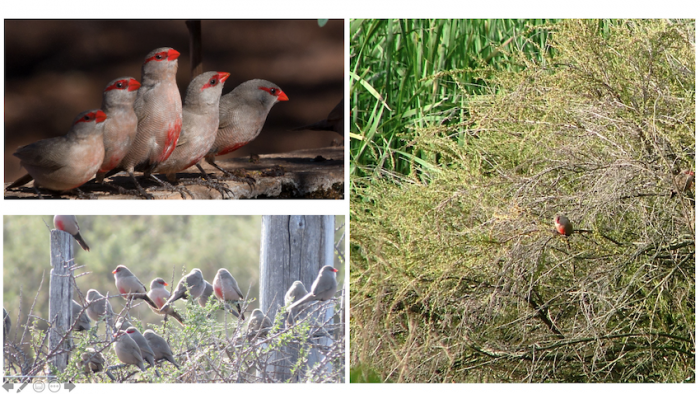Identification
Common Waxbills are small greyish-brown birds. This species is not sexually dimorphic; males females look the same. Overall, the Common Waxbill is greyish-brown and covered in thin, dark bars. In addition to barring, many birds also have a reddish streak running from their chest to their belly. Though these are all important clues, the easiest way to identify a common waxbill is by its bright red bill and the characteristic “mask” across its eyes. Young birds look very much like adults with two exceptions: the bill is blackish rather than red, and their overall colouration is duller with less distinct barring.

Dieter Oschadleus, Cape Town, Western Cape. 3 September 2016; 3 December 2016. BirdPix 29265; 32832
Common Waxbills do not have the most musical of songs; in fact, you are more likely to hear a contact call used to communicate to one another when foraging in a flock or in flight. You can listen to their song and call here.
Distribution
Except for the very driest parts of the interior, namely the Kalahari and Namib Deserts, these birds are common throughout southern Africa. On this SABAP2 map, see if you can find the Orange River—the Common Waxbill distribution closely follows its path!

Although this map only shows southern Africa, Common Waxbills are not unique to the region and occur in many African countries south of the Sahara desert. The species has also been introduced in countries where it did not originally occur, including Portugal and Spain in Europe, Brazil in South America, Puerto Rico in the Caribbean, and several island nations in the Atlantic, South Pacific, and Indian Oceans.
Habitat
The majority of the Common Waxbill’s diet consists of seeds and flowers from grasses, sedges, and some trees. They will also snack on the occasional insect, but their seed-loving tendencies confine them to a few specific habitat types.

Waxbills like edges; rushes, reeds, and grasses along the edge of rivers, grasses growing around cultivated land, and thick, tangly vegetation along watercourses. They will also readily visit seed feeders in gardens—keep an ear out for those distinctive contact calls signalling their arrival!

Behaviour
Common Waxbills are gregarious birds. When breeding, they birds may be seen in small family groups or male-female pairs; outside of the breeding season, they often gather in bigger flocks to forage, sometimes with other seed-eating species. At night, Common Waxbills use communal roosts, sites in reeds or bushes where large groups of birds all rest together.

Common Waxbills tend to nest alone as male-female pairs. Males and females work together to build a nest on or just above the ground, with males creating a messy teardrop-shaped hollow from grasses and stems, and females adding soft grasses and feathers for lining. Many pairs will also build a fake nest on top of their real nest, perhaps to confuse potential predators.
In addition to raising their own young, Common Waxbills often take on the role of surrogate parents, whether they like it or not. They are the host species of choice for another common seed-eating bird, the Pin-tailed Whydah, which is a brood parasite. You can read more about this behaviour by visiting the Pin-tailed Whydah page.
Further resources
Species text in the first bird atlas (1997)
Virtual Museum (BirdPix > Search VM > By Scientific or Common Name)
More common names: Rooibeksysie (Afrikaans); Astrild ondulé (French); Wellenastrild (German); Astrilde commune (Italian); Pico de Coral (Spanish)
A list of bird species in this format is available here.
Recommended citation format: Daniel KA 2021. Common Waxbill Estrilda astrild. Biodiversity and Development Institute. Available online at https://thebdi.org/2021/10/28/common-waxbill-estrilda-astrild/

